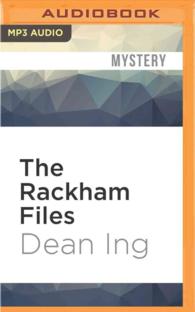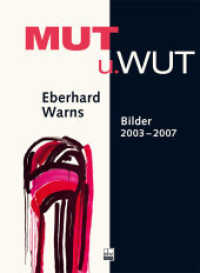- ホーム
- > 洋書
- > 英文書
- > History / World
Full Description
This important book addresses critical themes in the development of archaeology as a reflexive, self-critical discipline in the modern world. It explores the ethical, political and cultural tensions and responsibilities which need to be addressed by archaeologists when working within networks of global ecologies and communities, examining how authoritarian traditions can exacerbate the divide between expert and public knowledge. Moreover, it analyses how localized acts of archaeology relate to changing conceptions of risk, heritage, culture, identity, and conflict. Bringing insights from Alain Schnapp, Michael Shanks, Isabelle Stengers, Bruno Latour, Ulrich Beck, John Urry and others to cross-disciplinary discussions of these themes, Unquiet Pasts shows how archaeological discourse can contribute towards engaging and understanding current dilemmas. It also shows how archaeology, as a localized and responsibly exercised practice, can play a part in building our commonly shared and experienced world.
Contents
Contents: Preface: 'playing statues'; Introduction: rethinking 'crises over representation', Stephanie Koerner; Part 1 Risk Society: Introduction to part 1: contextualising contradictory trends of globalisation and risk society, Stephanie Koerner; Re-playing the past in an age of mechanical reproduction, Andrew Cochrane; Nation/First Nations: conflicts in identity and the role of archaeology, Roberta Robin Dods; Nation, identity and ideology; Romanità and Portugalidade under the Fascist dictatorships, Sergio Gomes; The social and political significance of prehistoric archaeology in modern and post-modern societies, Ulf Ickerodt; Art after 'primitivism': revisiting the 'non' of the 'contemporary/non-Western' dichotomy, Tom Lane; Doku-porn: visualising stratigraphy, Geoff Carver; Doing archaeology in the risk environment: a theoretical sketch, some observations and propositions, Koji Mizoguchi; Interface 1: redesigning mobilities, John Urry and Stephanie Koerner. Part 2 Lived Cultural Heritage: Introduction to part 2: changing approaches to heritage, Stephanie Koerner; Coming full circle: public archaeology as a liberal social programme: then and now, John Carman; Manual and intellectual labour in archaeology: past and present in human resource management, Nathan Schlanger; 'Let's not go to the dogs tonight': rhetoric as a strategy of accountability in archaeological outreach, Bo Jensen; Rethinking the political implications of statics and dynamics at the site of Castanheiro do Vento, Portugal, Ana Vale; Integrate plurality of landscapes and public involvements into Maltese environmental policy, Steven Vella and Marlene Borg; The academy and the public, Don Henson; Exotic objects, uncanny encounters: anthropological knowledge, tourism and challenges of representing a World Heritage Site, Marta De Magalhães; Interface 2: re-discovering the variety of discovering pasts, Alain Schnapp and Stephanie Koerner. Part 3 Re-Designing Reflexivity or Can There Be a Cautious Pro








